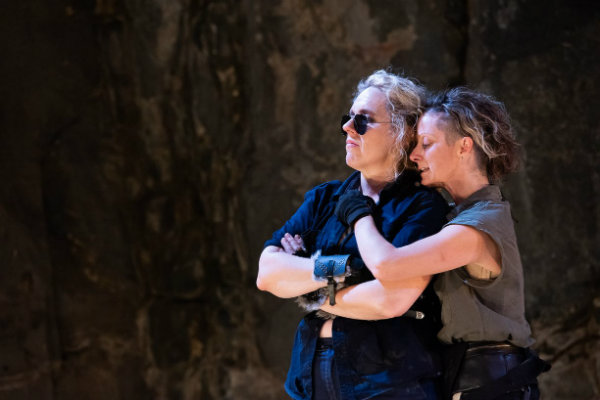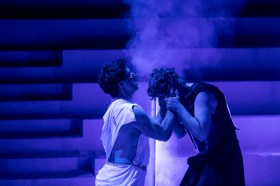Božo Vrećo performs at Ten Days on the Island. Photograph by Barefoot Photographer (José Navarro).
At the launch of Ten Days on the Island, Artistic Director Lindy Hume stated: ‘Art and artists illuminate our interior landscapes and, even if they’re not always comfortable places, help us see and understand them’. A powerful sentiment in a time in which Australia finds itself at a crossroads of extreme political views and increasingly in contact with some of the most ugly sides of human nature.
Hume’s outlook was clearly reflected in the programming of the festival, and particularly in the south of lutruwita (Tasmania). The work showcased here was a rich, dense offering that excavated the very essence of our humanity. Sometimes gently, sometimes with a brutal sensibility that revealed the darker parts of our nature. Here in the South we see anger and our will for change – The Stance. Our loss and a tender call for understanding – Compassion. We see our fears, and our call to embrace the strength in physical frailty – Eyes as Big as Plates – and our gendered dilemmas and desires – The Mares.
In Compassion, Nigel Westlake conducts The Tasmanian Symphony Orchestra in a work vocalised with gusto and skill by Lior. It’s a powerful performance, potently of its time, sung in Hebrew and Arabic and translated artfully by Tasmanian musicians. In Compassion, Westlake has created the kind of beauty that draws you into the solitary pleasure of closing your eyes and allowing the performance to drench you in sound. When you open them again you are rewarded via Concertmaster Emma McGrath who holds you mesmerised as she plays her violin with utter commitment and with her whole body. Or by Lior whose expressive hands seemingly serve as a conductor to his vocal cords. The Orchestra works respectfully in synchronicity. The work is disciplined, beautiful and significant.
This approach – bringing together local collaborators with visiting national and international artists – is a choice that runs throughout the Festival. Hume has carefully and deliberately programmed work that reflects this desire to connect, to make locally relevant, and to build the capacity and connectivity of practitioners here in Tasmania. The program is a celebration of the very purposes I outlined in my review of the Festival’s first weekend and it’s a key as to why the creative offerings are not only cohesive as a whole, but also celebrate the diversity of the regions which Ten Days activates.
THE FEAR AND DELIGHT OF GROWING OLD
In the popular exhibition, Eyes as Big as Plates, Scandinavian collaborators Riitta Ikonen and Karoline Hjorth bring their photographic and sculptural project to Hobart, and create an indelible legacy with a handful of Tasmanian treasures in the process.
The large-scale photographic exhibition, staged at Salamanca Arts Centre’s Long Gallery, speaks to our humanity and both the fear and delight of growing old. Shot on Kodak film, the artists portray elders from all over the world in the landscape of their choosing, transforming them into mythical presences, adorned in shells and flora. In Tasmania they added seven new portraits to the exhibition. We see Max from Boat Harbour adorned by ‘old man Banksias’ (Banksia Serata) recalling his barefoot childhood, and Uncle Allen, a Tasmanian Aboriginal man immersed in the landscape of Bruny Island as if nature and himself were one and the same.
Hjorth and Ikonen’s practice involves approaching strangers in hardware stores, cafes and the street, being simultaneously shameless and warm in their requests and developing a keen eye for interesting stories and interesting people. They build trust quickly and pride themselves on the lack of manipulation in their work. Their natural charm and sincerity mean that they put their subjects at ease and the resulting photographs capture the very essence of each person.
Describing themselves as ‘introverts with purpose’ these two artists have travelled across the world since 2011 adding to their exhibitions by collaborating with local communities; the next will be in Scotland.
Their large-scale portraiture is striking, bold and connects cross-generationally and cross-culturally. It’s particularly lovely to see how children in the gallery react to the work. When I was visiting, a four year old whispered to her mother, ‘I like the woman with the sticks in her hair,’ to which her mother replied, ‘She looks like a floating mermaid’.
IMPORTANT CONVERSATIONS
At the launch of Ten Days on the Island Lindy Hume shared her vision for the festival. As part of her launch speech, she said, ‘Placing the fabric of local narratives and landscapes – a fabric into which Tasmanian lives and stories are woven – in an international festival context, is a way of expressing both our connectedness to the world and our uniqueness in the world’.
In the South, as it has been throughout, the Ten Days team is engaged with the artistic community, undertaking public conversations with the sector. Both the future of performance in Tasmania, and Australian First Nations work are of particular importance to the arts ecology in Tasmania and the Festival recognises the important role that they play within this ecosystem. It’s a refreshingly transparent and generous approach – although not without its boundaries; they are realistic about their capacity. The budget is not infinite and nor is the process. As is the process with every curated festival there will be inevitably more ‘nos’ than ‘yesses’. The festival in its entirety needs to have a coherent narrative that expresses the key themes and visioning of its Artistic Director.
Here in Hobart the festival team are facilitating robust and pragmatic public discussions with the arts community regarding sustainability, building audiences, supporting mid career artistic provocations and creating pathways for young and emerging artists. They are not unfamiliar issues to those on mainland Australia, but they are particularly magnified here in Tasmania, in part due to the size of the population base and the size of the industry and audiences.

DRILL’s The Stance, Photo credit: Josh Lowe.
Josh Lowe is a great example of a young Tasmanian artist, who through the support of various organisations has paved a pathway for himself and his professional dance practice. He is currently the Artistic Director of youth dance company DRILL, whose work, The Stance, choreographed by Liesel Zinc, was staged in the Elizabeth Street Mall in Hobart as part of Ten Days.
The Stance is an in situ dance and sound performance, inspired by the physical language of bodies and voices in protest. It has reached Tasmania after performances in Asia, mainland Australia and Europe, and has been reimagined specifically within a Tasmanian context. In this iteration it weaves the voices of young Tasmanians into the soundtrack, relayed to the audience via wireless headsets. DRILL’s Senior Ensemble translates a committed and epic durational performance in the Elizabeth Street Mall over the space of two and a half hours.
When I visit the work there is a viewer who was a participant in a rally referenced in the physical language of the work, an Aboriginal man who recalls the very moment the protesters lay face down in a line during the land rights protests. It’s an evocative reminder of the both the potency of work in public space and the rigorous nature of the work.

Tasmanian Theatre Company’s The Mares. Photo credit: Amy Brown.
One of the key highlights of the Festival in the South was The Mares, produced in collaboration between Ten Days on the Island and Tasmanian Theatre Company. This was a sold out, world premiere of an astounding piece of theatre written by Kate Mulvany, directed by Leticia Cáceres and translated by an ensemble of Tasmanian performers. The impact on Tasmanian audiences and industry members was clear. It was the kind of work that rippled into public and professional conversations about craft and risk but also one which brought its central themes into everyday conversation and debate. Generated in Tasmania, it’s the kind of world-class theatre that deserves to be more broadly seen via touring.
Hume’s goal for her festival ‘to be a gathering place for communities, artists and audiences, to celebrate shared humanity and consider the complex, turbulent world around us,’ is well realised here in the South, as it is throughout the festival. As artists and audiences we have been guided together by the astute hand of Artistic Director Lindy Hume and the collaborative and highly skilled core Festival team, led by CEO Jane Haley. A balance of risk, the intimate and the epic, we’ve seen work in sheds, concert halls, theatres and galleries, in a shopping mall and on a beach and at each step we’ve encountered work which is both excellent and thoughtful.
I started this adventure through the heartlands of Tasmania in a Winnebago with the dog, blury-eyed at dawn on a beach in Devonport for Mapali and I’ve ended it in the bowels of Mona watching in quiet glee as transgendered performer Božo Vrećo entertains a Bosnian grandmother in her native tongue. It’s been a blast. Can we do it all again in 2021?






